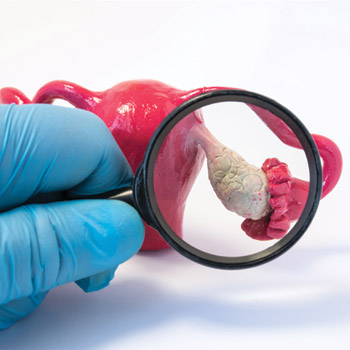MKSAP Quiz: New lesion on the side of the face
A 44-year-old man is evaluated for a new lesion on the side of his face. It has been present for several months and is asymptomatic. When he shaves he cuts it, and it starts bleeding. He is otherwise healthy and takes no medications.

On physical examination, vital signs are normal. Skin findings are shown.
The remainder of the examination is normal.
Which of the following is the mostly likely diagnosis?
A. Basal cell carcinoma
B. Dermal nevus
C. Keratoacanthoma
D. Nodular melanoma
E. Squamous cell carcinoma
Answer and critique
The most likely diagnosis is A. Basal cell carcinoma. This question can be found in MKSAP 18 in the Dermatology section, item 22.
The patient has a basal cell carcinoma, the most common type of skin cancer. The lesion demonstrates typical findings with a translucent (pearly) papule and arborizing telangiectasias. It typically appears on sun-exposed areas in fair-skinned persons with a history of extensive sun exposure. It is usually asymptomatic and enlarges slowly over time. Although it rarely metastasizes, basal cell carcinoma can cause significant local tissue destruction if not removed.
Melanocytic nevi, often referred to as “moles,” are found in persons of all ages. They are benign collections of melanocytes and histologically consist of nests of melanocytes occurring at the dermal-epidermal junction and dermis. They occur most commonly in sun-exposed areas. Junctional nevi are flat and often dark brown in color. Compound nevi are raised (papules) and may be irregularly pigmented. Dermal nevi are soft and flesh-colored and may resemble skin tags. This patient's translucent papule with telangiectasias is not consistent with the findings of a dermal nevus.
Keratoacanthomas tend to be rapidly growing pink nodules with a crusted hyperkeratotic core or central crater of crust and scale (“volcaniform”). Keratoacanthomas usually stabilize after a period of rapid growth and then slowly involute, eventually resolving completely. Since some lesions fail to resolve completely and may persist, they are usually treated with surgical excision. A rapidly growing nodule with a hyperkeratotic core is not consistent with this patient's findings.
Melanoma is a neoplasm of the pigment-making cells, melanocytes. The clinical features that suggest melanoma are represented by the mnemonic “ABCDE,” where “A” stands for Asymmetry, “B” for irregular Border, “C” for multiple Colors, “D” for Diameter greater than 6 mm, and “E” for Evolution, meaning increasing size. Melanoma may be further classified into several different subtypes. Nodular melanomas are the most aggressive subtype and have an invasive component from the beginning. A nodular melanoma appears as a darkly pigmented, pedunculated, or polypoid nodule. Amelanotic variants do occur but are rare. The patient's translucent nodule is not consistent with the typical findings of a nodular melanoma.
Squamous cell carcinoma is the second most common type of skin cancer and the most common skin cancer in persons who are immunocompromised following solid organ transplant. Squamous cell carcinoma appears as a pink hyperkeratotic papule or nodule. Compared with basal cell carcinoma, it usually has scale and does not have that translucent, pearly appearance.
Key Point
- Basal cell carcinoma appears as asymptomatic translucent telangiectatic papules on sun-exposed areas in fair-skinned persons.




